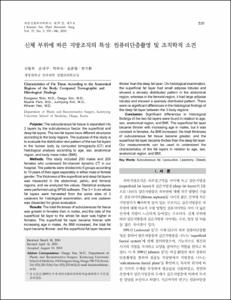KUMEL Repository
1. Journal Papers (연구논문)
1. School of Medicine (의과대학)
Dept. of Plastic Surgery (성형외과학)
신체 부위에 따른 지방조직의 특성: 컴퓨터단층촬영 및 조직학적 소견
- Alternative Author(s)
- Son, Dae Gu; Park, Mu Sik; Kim, Jun Hyung; Han, Ki Hwan
- Journal Title
- 대한성형외과학회지
- ISSN
- 1015-6402
- Issued Date
- 2010
- Abstract
- Purpose: The subcutaneous fat tissue is separated into
2 layers by the subcutaneous fascia: the superficial and
deep fat layers. The two fat layers have different structures
according to the body regions. The purpose of this study is
to evaluate the distribution and pattern of the two fat layers
in the human body by computed tomography (CT) and
histological analysis according to age, sex, anatomical
region, and body mass index (BMI).
Methods: This study included 200 males and 200
females who underwent 64-channel dynamic CT in our
hospital. The patients were divided into 5 groups according
to 10 years of their ages separately in either male or female
gender. The thickness of the superficial and deep fat layers
was measured in the abdominal, pelvic, and femoral
regions, and we analyzed the values. Statistical analyses
were performed using SPSS software. The 3 × 3-cm whole
fat layers were harvested from the same sites of 3
cadavers for histological examination, and one cadaver
was dissected for gross evaluation.
Results: The total thickness of subcutaneous fat tissue
was greater in females than in males, and the ratio of the
superficial fat layer to the whole fat layer was higher in
females. The superficial fat layer became thinner with
increasing age in males. As BMI increased, the total fat
layer became thicker, and the superficial fat layer became thicker than the deep fat layer. On histological examination,
the superficial fat layer had small adipose lobules and
showed a densely distributed pattern in the abdominal
region, whereas in the femoral region, it had large adipose
lobules and showed a sparsely distributed pattern. There
were no significant differences in the histological findings of
the deep fat layer between the 3 body regions.
Conclusion: Significant differences in histological
findings of the two fat layers were found in relation to age,
sex, anatomical region, and BMI. The superficial fat layer
became thinner with increasing age in males, but it was
constant in females. As BMI increased, the total thickness
of subcutaneous fat tissue became greater, and the
superficial fat layer became thicker than the deep fat layer.
Our measurements can be used to understand the
characteristics of the fat layers in relation to age, sex,
anatomical region, and BMI.
Key Words: Subcutaneous fat, Liposuction, Lipectomy, Obesity
- Alternative Title
- Characteristics of Fat Tissue According to the Anatomical
Regions of the Body: Computed Tomographic and
Histological Findings
- Department
- Dept. of Plastic Surgery (성형외과학)
- Publisher
- School of Medicine
- Citation
- 신동우 et al. (2010). 신체 부위에 따른 지방조직의 특성: 컴퓨터단층촬영 및 조직학적 소견. 대한성형외과학회지, 37(5), 535–546.
- Type
- Article
- ISSN
- 1015-6402
- Appears in Collections:
- 1. School of Medicine (의과대학) > Dept. of Plastic Surgery (성형외과학)
- 파일 목록
-
-
Download
 oak-bbb-2267.pdf
기타 데이터 / 1.45 MB / Adobe PDF
oak-bbb-2267.pdf
기타 데이터 / 1.45 MB / Adobe PDF
-
Items in Repository are protected by copyright, with all rights reserved, unless otherwise indicated.